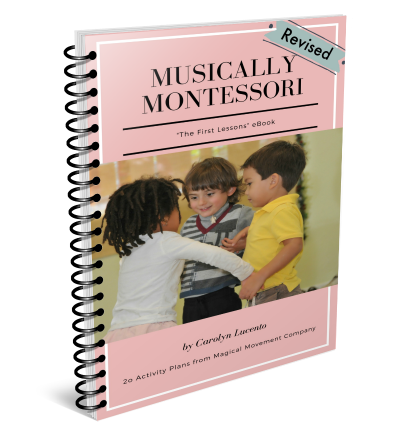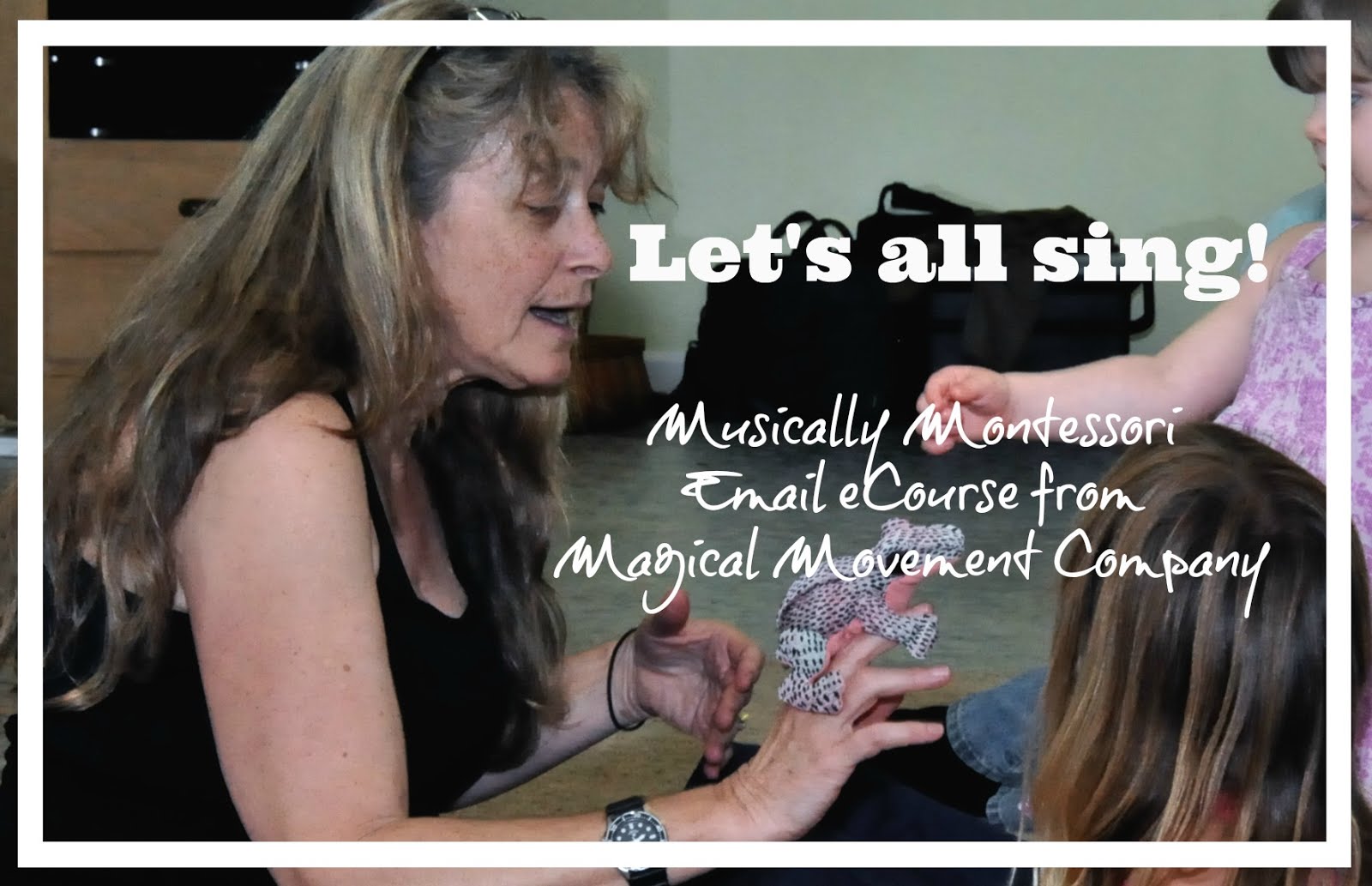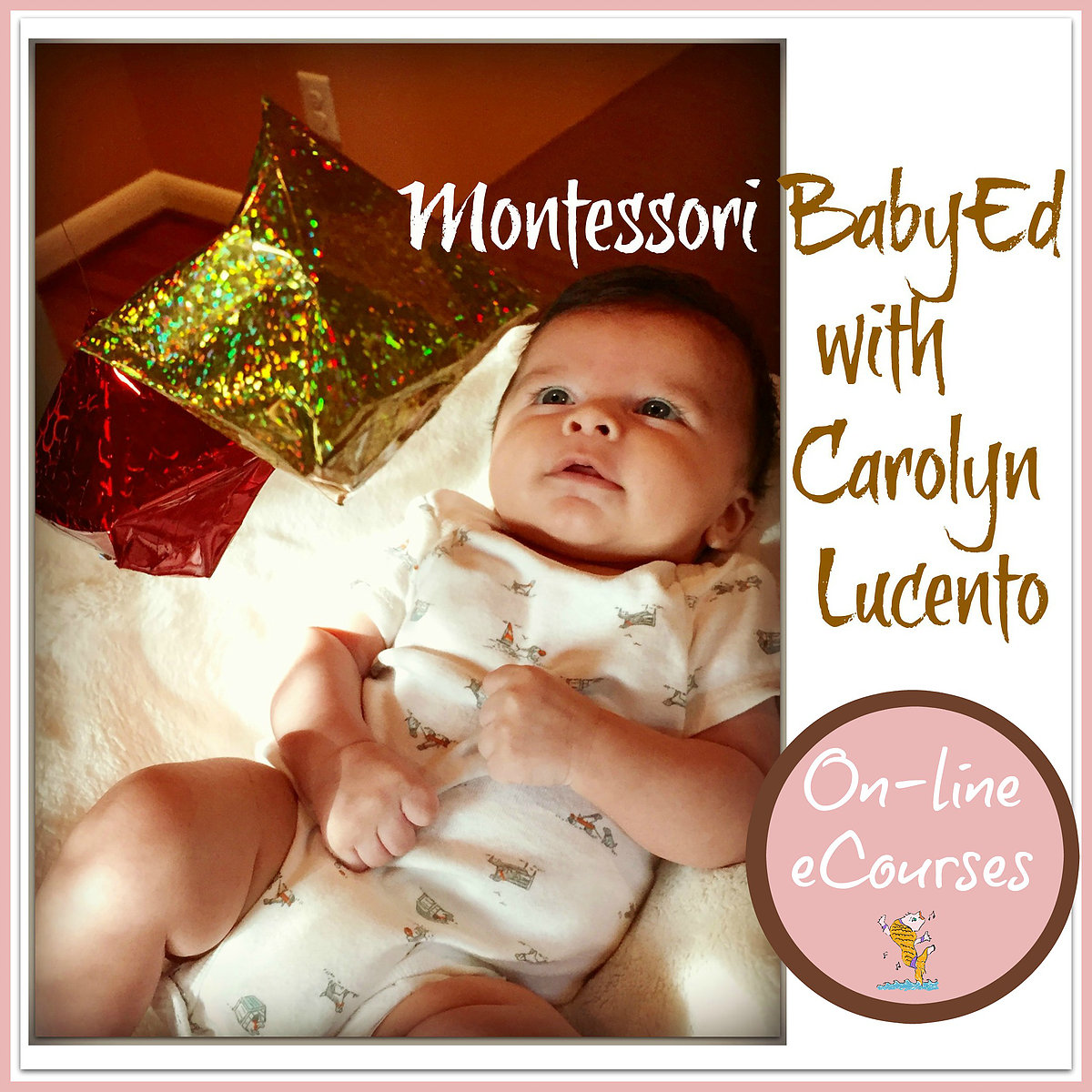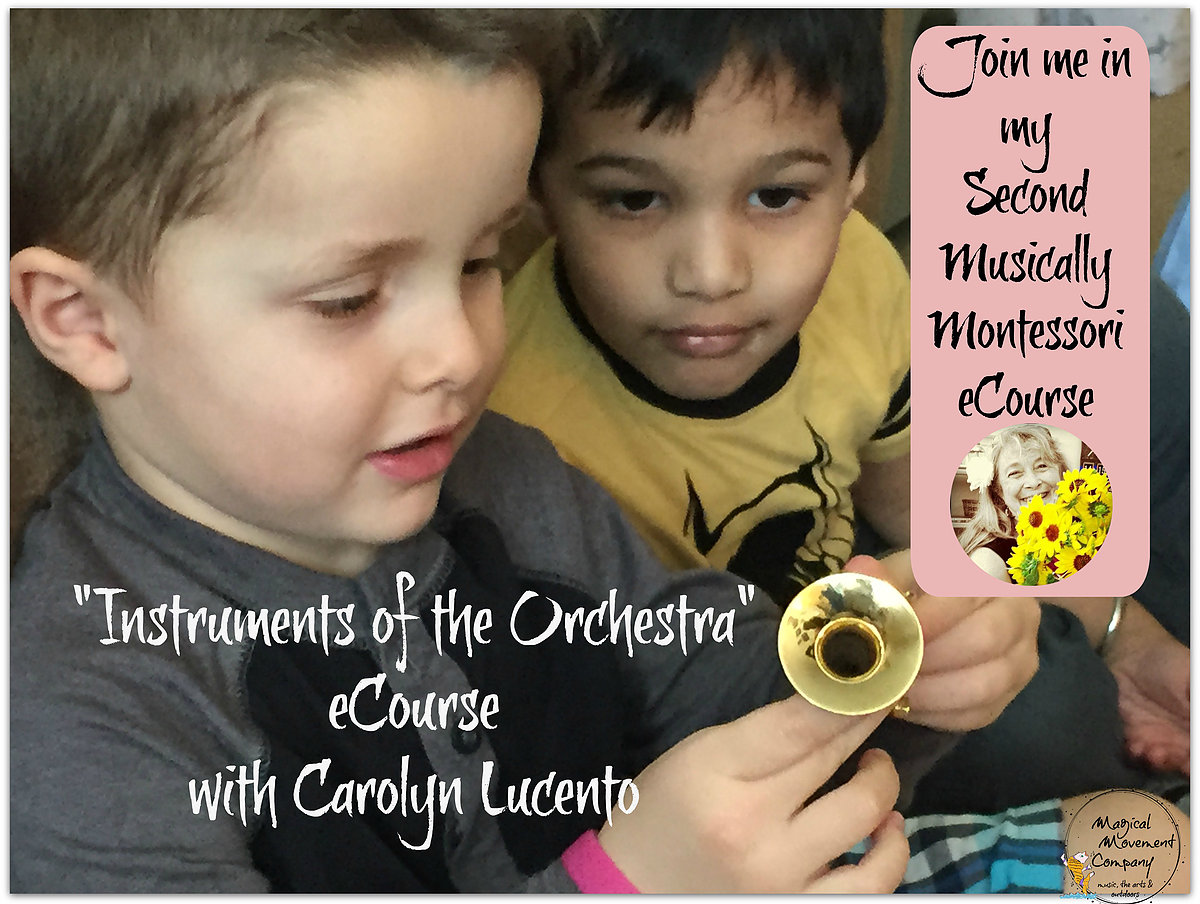EXPLORING THE MUSIC CONCEPTS OF "HIGH & LOW" CAN SOMETIMES BE CHALLENGING...ALL THE MORE REASON TO MAKE IT FUN FOR THE YOUNG CHILD!
Recently, our Montessori Music classes have been filled with activities about distinguishing between High and Low with an emphasis on HAVING FUN!
We always begin our classes with warm-ups for the hands, the voice & the whole body, and these have been focused on "high and low" in fun ways. You can learn more about my warm ups and view a little video at my past post: Musically Montessori #6 A Sequential Curriculum for Everyday Music with Young Children.
The children really enjoy practicing the sound, "mi" in their high voices. Then, we make the sound, "moo" in a low voice and I always find it very interesting how closely the children match my pitch! I sometimes use the kids warm up version of Bob Marley's One Love from a fantastic cd by the renowned vocal coach Susan Anders. Here's the link: One Love Introduction.
Another warm up song from Susan's cd that the children really love is The Lion Sleeps Tonight (that song from the 1960's that is now part of the Lion King story). You can find this song through the link above.
This week, I chose most of the lesson activities from my favorite music curriculum, Music Room from the Australian company called Bushfire Press. Here's their link: Music Room Book One.
NOWADAYS, YOU CAN PURCHASE THE BEGINNING LESSONS OF MUSIC ROOM ONE AS an iBook from iTunes for $3.99!
I don't know how long this fantastic deal will last, but I downloaded it last week and it's a must! There are 21 song & musical activities (mp3 music format), four lesson plans, and even some visuals you can print off to use with your children! The 2 lessons on High & Low are the basis of the fun activities I have been offering to the children during the past few weeks of music classes in the Montessori Preschools where I teach. Here's the link for this wonderful resource:eMusic Room Book 1a.
I am so excited to have RECENTLY BECOME A TRAINER FOR THE MUSIC ROOM CURRICULUM and I'll be OFFERING AN ON-LINE eCOURSE/TRAINING in February 2016!
You can be one of the first to get in on the first in this training series that I know will be very helpful and fun for classroom teachers & music specialists, as well as parents and caregivers of young children.
I will have little INSTRUCTIONAL VIDEOS to give you VIRTUAL HANDS ON EXPERIENCE with the lessons from the eMusic Room curriculum and there will be LOTS OF EXTRAS LIKE:
You can sign up for my email subscription list and you'll receive my updates straight to your inbox! Subscribe for updates at this link:Magical Movement Company Subscribe for Updates.
A favorite activity for the children has been the "High & Low Listening Game." The children prepared their ears for focused listening by rubbing them gently around the edges to sensitize the ears for listening. Then, I turned on the Music Room cd and we heard some sounds (human voices) that were either high, or low. The children put their hands up in the air if the sound was a high sound and they put their hands on the floor if it was a low sound.
The first sound was a baby's voice making sounds of delight in a very high pitch. This was quite entertaining for the children, since they recognized it was a baby right away and these little ones are just getting out of babyhood themselves!
The next sound was the sound of a man snoring! It was hilarious and the children were surprised and laughing throughout! This was definitely a low sound!
The game got more and more interesting with the sounds getting funnier as the game progressed! The children were full of laughter and from my observation, I saw that some of the younger ones were still a little unsure of whether the sounds were high or low, so this funny game was also an important exercise in distinguishing the pitch of familiar sounds (the human voice!).
Next, we had a great time singing the song from Lesson 3 of this eMusic Room unit called "High & Low Challenge". I brought my Xylophone to class and played either a high note or a low note on this wonderful Orff tuned percussion instrument. The words to the song go like this:
So, when I played a high note on the Xylophone, the children once again raised their hands up in the air and when I played a low note they placed their hands down on the floor. By the end of the activity, the children were singing the catchy little tune perfectly!
In the Kindergarten & First Grade classrooms, we passed the Xylophone around the circle and each child played either a high note or a low note while the rest of us sang the song. Then the children put their hands up high or down low depending on what they heard.
Whenever I introduce the Xylophone to a group of children, I point out that the way we know it is a Xylophone is because the bars are made of wood. I show them the bars and give them that vocabulary, then I ask, "Are these bars made of metal or of wood?"
For the younger groups, I took the Xylophone around for each child to play a little something. I reinforced when the child played a high note or a low note by singing "High...low" according to what was played. In the photo below, you'll see the classic Orff Xylophone (designed from the original Orff-Schulwerk method developed by the composer Carl Orff in the early 1900's.) You can learn more about Orff-Schulwerk at my website. Here is that link: Classes & Workshops .
And you can see a video explaining the Orff-Sculwerk method of music education at this link: Videos.
Beautiful Orff style Xylophones for children are available on Amazon at this link: Studio 49 Xylophone at Amazon. and more on this page:Xylophones on Amazon.
Before passing the Xylophone around to each child, I showed them the mallets that are used to play the instrument. First, the children repeated the name, "mallet", then I asked them to pretend they were holding the mallets one in each hand. Then I showed them how to pretend to hold the mallets like they were the handlebars of a bicycle and I asked the children to keep their elbows lifted and their wrists strong but loose.
Every single child (more than 750 throughout the week!) played with such care and made beautiful sounds come out of the Xylophone. I was amazed at how many of these little ones actually played a low note, then a high note with intention and grace. And, what big smiles were on their faces!
At the end of every music lesson, I always give each child a stamp on the hand to end the class. The rubber stamp this week was a rendition of a Xylophone and the children were pretty excited! I told them the picture on the stamp was one of the kind of Xylophone that you would see played in the Orchestra. It is much bigger than the one we played and has more bars, is longer and is up on a stand so that you would play it while standing up.
I have seen traditional Xylophones (wooden bars, not metal) for children at both Lakeshore Teacher Supplies and also at Montessori Services. These are entirely appropriate for using in the above activities that I described, and if you have the Montessori Bells in your environment, you can easily substitute them for the Xylophone! I have often used the lovely Montessori Brass bells for lessons with the "High & Low" games and later the children can manipulate these bells on their own as an individualized activity at work time.
For some added fun, I played my slide whistle for the children! Once again, the children raised their hands up high when the slide whistle went up to the high pitch. Then the children placed their hands on the floor when the slide whistle went down to the low pitch. The really fun part for the children is when I "try to trick them"... (Ex: by playing the slide whistle in a random pattern, like high/ low/ high/ low/ low...high/ low/ high / high!) Lots of giggles!
Yes, You can even find slide whistles at Amazon! Here's that link: Slide Whistles at Amazon.com.
It is surprising how many young children don't quite understand and distinguish the high sounds and the low sounds in music! Sometimes, I think they may simply be struggling with the music vocabulary (high vs low). Whatever the reason, offering fun activities with "High & Low games" strengthens auditory discrimination skills and helps train the ear for singing (and playing) in tune. Very important for a child's development in both music and the joys of a full life!
When we end our music classes we sing a good bye song. There is some echo singing in this song and so I have fun singing in my high voice for the children to echo with their high voices. Then, I sing in my low voice for that fun low echo from the children! Just more reinforcement of the concepts of high and low in music education...in a fun way! You can easily do this with any of the songs your children like to sing: the more familiar the song, the better!
I am so happy to have you visiting my Blog and I hope you have lots of fun with high and low games in your music circles with your group. I love to hear you ideas, so please feel free to leave a comment in the section below!
View Post
Recently, our Montessori Music classes have been filled with activities about distinguishing between High and Low with an emphasis on HAVING FUN!
We always begin our classes with warm-ups for the hands, the voice & the whole body, and these have been focused on "high and low" in fun ways. You can learn more about my warm ups and view a little video at my past post: Musically Montessori #6 A Sequential Curriculum for Everyday Music with Young Children.
The children really enjoy practicing the sound, "mi" in their high voices. Then, we make the sound, "moo" in a low voice and I always find it very interesting how closely the children match my pitch! I sometimes use the kids warm up version of Bob Marley's One Love from a fantastic cd by the renowned vocal coach Susan Anders. Here's the link: One Love Introduction.
Another warm up song from Susan's cd that the children really love is The Lion Sleeps Tonight (that song from the 1960's that is now part of the Lion King story). You can find this song through the link above.
This week, I chose most of the lesson activities from my favorite music curriculum, Music Room from the Australian company called Bushfire Press. Here's their link: Music Room Book One.
NOWADAYS, YOU CAN PURCHASE THE BEGINNING LESSONS OF MUSIC ROOM ONE AS an iBook from iTunes for $3.99!
I don't know how long this fantastic deal will last, but I downloaded it last week and it's a must! There are 21 song & musical activities (mp3 music format), four lesson plans, and even some visuals you can print off to use with your children! The 2 lessons on High & Low are the basis of the fun activities I have been offering to the children during the past few weeks of music classes in the Montessori Preschools where I teach. Here's the link for this wonderful resource:eMusic Room Book 1a.
I am so excited to have RECENTLY BECOME A TRAINER FOR THE MUSIC ROOM CURRICULUM and I'll be OFFERING AN ON-LINE eCOURSE/TRAINING in February 2016!
You can be one of the first to get in on the first in this training series that I know will be very helpful and fun for classroom teachers & music specialists, as well as parents and caregivers of young children.
I will have little INSTRUCTIONAL VIDEOS to give you VIRTUAL HANDS ON EXPERIENCE with the lessons from the eMusic Room curriculum and there will be LOTS OF EXTRAS LIKE:
- music class management strategies that work
- ideas for Montessori-style extensions & embellishments,
- engaging techniques from my many years of experience and my Orff-Schulwerk training
- and much more!
You can sign up for my email subscription list and you'll receive my updates straight to your inbox! Subscribe for updates at this link:Magical Movement Company Subscribe for Updates.
A favorite activity for the children has been the "High & Low Listening Game." The children prepared their ears for focused listening by rubbing them gently around the edges to sensitize the ears for listening. Then, I turned on the Music Room cd and we heard some sounds (human voices) that were either high, or low. The children put their hands up in the air if the sound was a high sound and they put their hands on the floor if it was a low sound.
The first sound was a baby's voice making sounds of delight in a very high pitch. This was quite entertaining for the children, since they recognized it was a baby right away and these little ones are just getting out of babyhood themselves!
The next sound was the sound of a man snoring! It was hilarious and the children were surprised and laughing throughout! This was definitely a low sound!
The game got more and more interesting with the sounds getting funnier as the game progressed! The children were full of laughter and from my observation, I saw that some of the younger ones were still a little unsure of whether the sounds were high or low, so this funny game was also an important exercise in distinguishing the pitch of familiar sounds (the human voice!).
Next, we had a great time singing the song from Lesson 3 of this eMusic Room unit called "High & Low Challenge". I brought my Xylophone to class and played either a high note or a low note on this wonderful Orff tuned percussion instrument. The words to the song go like this:
Hey-ho! Off we go.
Am I high or am I low?
So, when I played a high note on the Xylophone, the children once again raised their hands up in the air and when I played a low note they placed their hands down on the floor. By the end of the activity, the children were singing the catchy little tune perfectly!
In the Kindergarten & First Grade classrooms, we passed the Xylophone around the circle and each child played either a high note or a low note while the rest of us sang the song. Then the children put their hands up high or down low depending on what they heard.
Whenever I introduce the Xylophone to a group of children, I point out that the way we know it is a Xylophone is because the bars are made of wood. I show them the bars and give them that vocabulary, then I ask, "Are these bars made of metal or of wood?"
For the younger groups, I took the Xylophone around for each child to play a little something. I reinforced when the child played a high note or a low note by singing "High...low" according to what was played. In the photo below, you'll see the classic Orff Xylophone (designed from the original Orff-Schulwerk method developed by the composer Carl Orff in the early 1900's.) You can learn more about Orff-Schulwerk at my website. Here is that link: Classes & Workshops .
And you can see a video explaining the Orff-Sculwerk method of music education at this link: Videos.
Before passing the Xylophone around to each child, I showed them the mallets that are used to play the instrument. First, the children repeated the name, "mallet", then I asked them to pretend they were holding the mallets one in each hand. Then I showed them how to pretend to hold the mallets like they were the handlebars of a bicycle and I asked the children to keep their elbows lifted and their wrists strong but loose.
Every single child (more than 750 throughout the week!) played with such care and made beautiful sounds come out of the Xylophone. I was amazed at how many of these little ones actually played a low note, then a high note with intention and grace. And, what big smiles were on their faces!
At the end of every music lesson, I always give each child a stamp on the hand to end the class. The rubber stamp this week was a rendition of a Xylophone and the children were pretty excited! I told them the picture on the stamp was one of the kind of Xylophone that you would see played in the Orchestra. It is much bigger than the one we played and has more bars, is longer and is up on a stand so that you would play it while standing up.
Below is a photo of what the Xylophone of the Orchestra looks like. I have several posts you might enjoy that tell more about the history of the Xylophone and also a youtube video of one of the greatest xylophonists, Teddy Brown. Here's that link: What About Music? Xylophones & Giraffes!
And this post has one of my quirky little videos showing my version of the Music Room "High & Low Challenge Game":
I have seen traditional Xylophones (wooden bars, not metal) for children at both Lakeshore Teacher Supplies and also at Montessori Services. These are entirely appropriate for using in the above activities that I described, and if you have the Montessori Bells in your environment, you can easily substitute them for the Xylophone! I have often used the lovely Montessori Brass bells for lessons with the "High & Low" games and later the children can manipulate these bells on their own as an individualized activity at work time.
For some added fun, I played my slide whistle for the children! Once again, the children raised their hands up high when the slide whistle went up to the high pitch. Then the children placed their hands on the floor when the slide whistle went down to the low pitch. The really fun part for the children is when I "try to trick them"... (Ex: by playing the slide whistle in a random pattern, like high/ low/ high/ low/ low...high/ low/ high / high!) Lots of giggles!
Yes, You can even find slide whistles at Amazon! Here's that link: Slide Whistles at Amazon.com.
It is surprising how many young children don't quite understand and distinguish the high sounds and the low sounds in music! Sometimes, I think they may simply be struggling with the music vocabulary (high vs low). Whatever the reason, offering fun activities with "High & Low games" strengthens auditory discrimination skills and helps train the ear for singing (and playing) in tune. Very important for a child's development in both music and the joys of a full life!
When we end our music classes we sing a good bye song. There is some echo singing in this song and so I have fun singing in my high voice for the children to echo with their high voices. Then, I sing in my low voice for that fun low echo from the children! Just more reinforcement of the concepts of high and low in music education...in a fun way! You can easily do this with any of the songs your children like to sing: the more familiar the song, the better!
I am so happy to have you visiting my Blog and I hope you have lots of fun with high and low games in your music circles with your group. I love to hear you ideas, so please feel free to leave a comment in the section below!
Advertising Disclosure: Magical Movement Company may be compensated in exchange for featured placement of certain sponsored products and services, or your clicking on links posted on this website. Thanks for your support!




































































